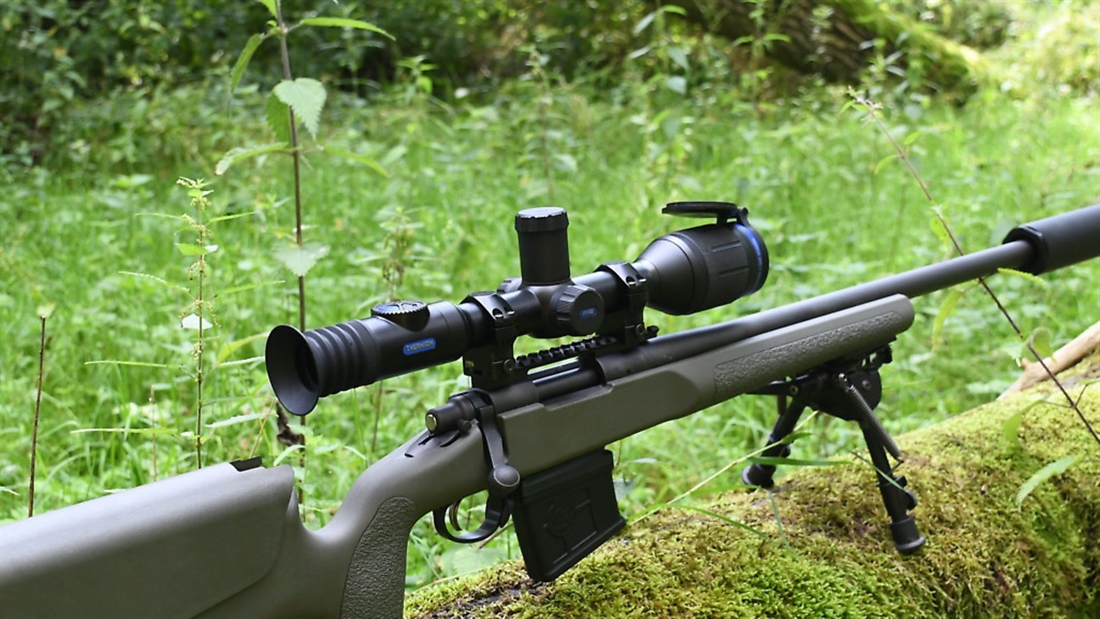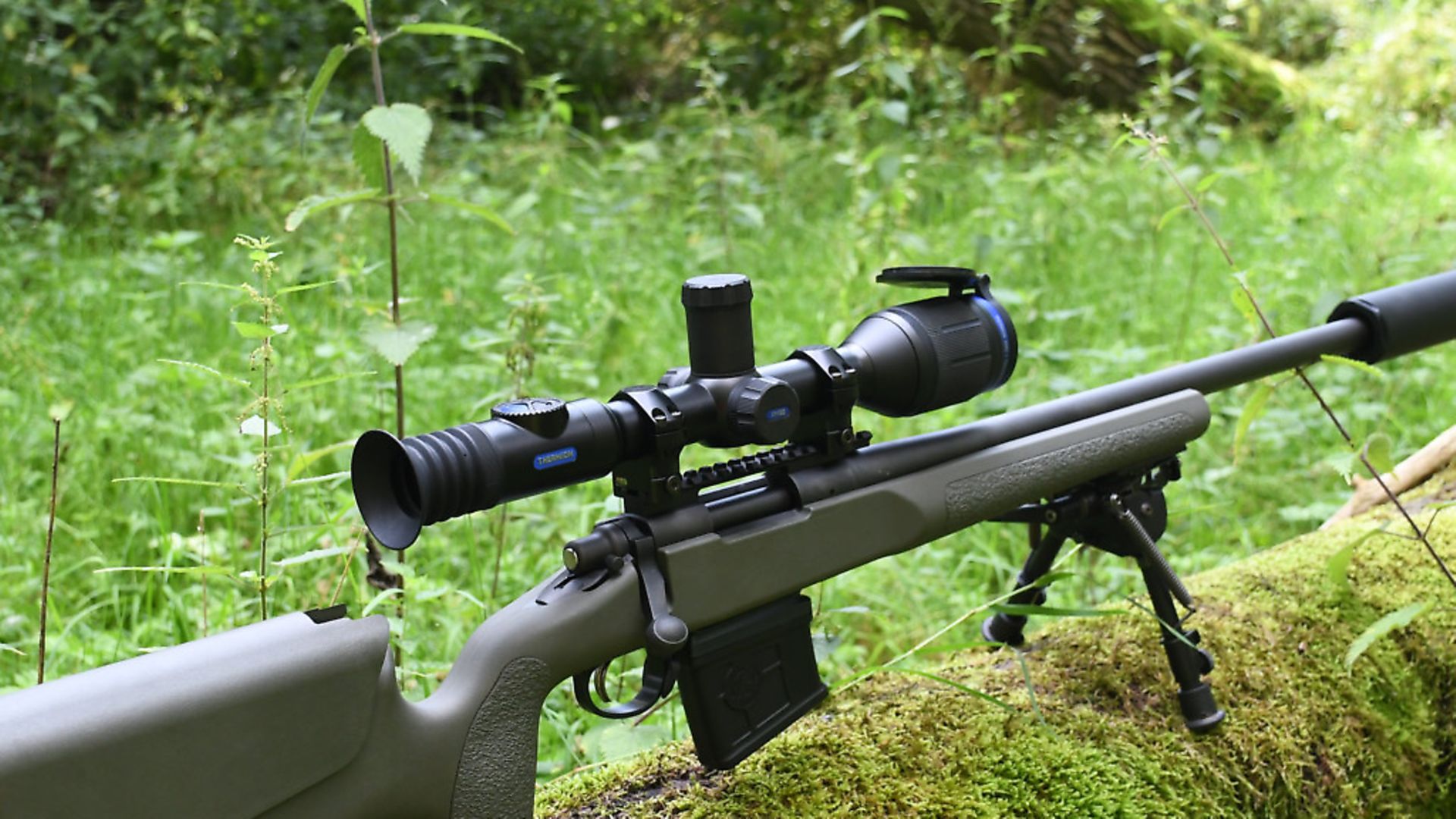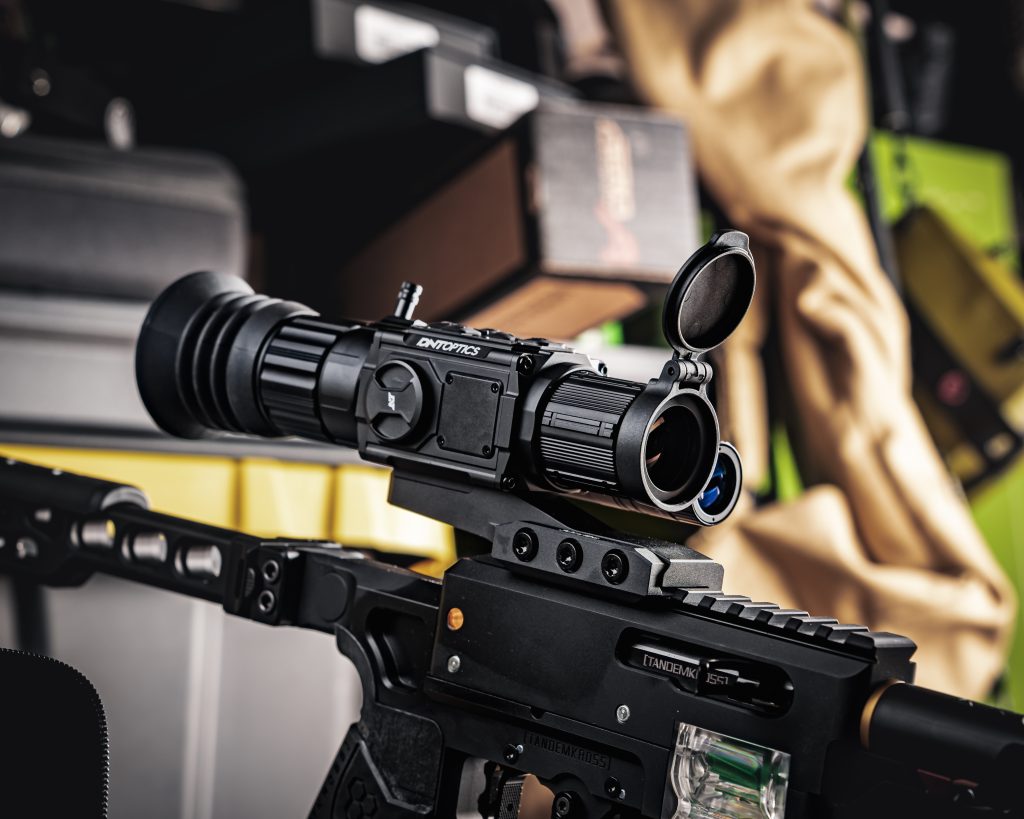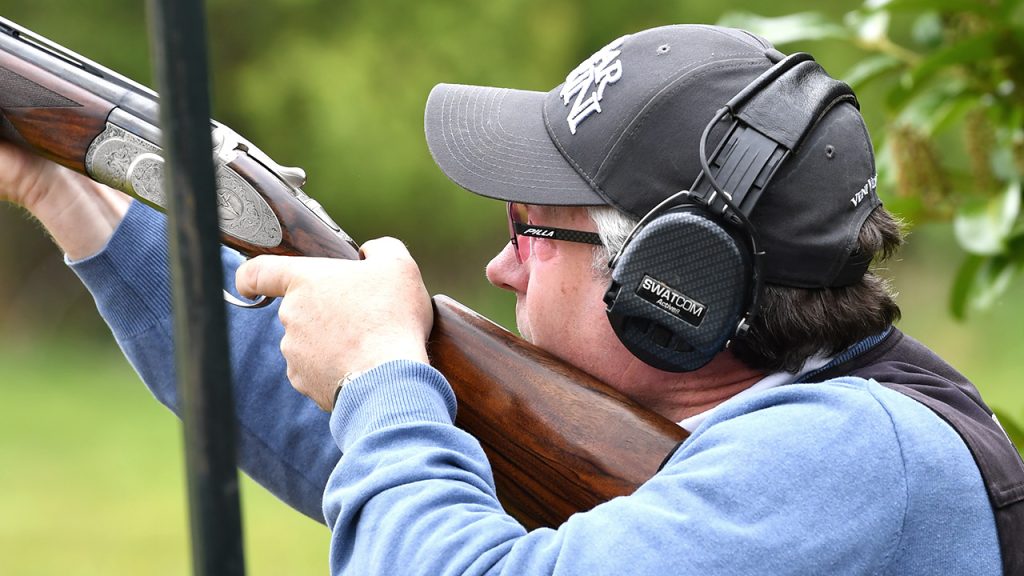Thermion XM50 thermal riflescope – test & review

The heat is on as Chris Parkin takes the Thermion XM50 thermal riflescope for a spin, and finds it to be a big step forward for Pulsar in the thermal market
BRIEF OVERVIEW – THERMION XM50 THERMAL RIFLESCOPE
FOR: Easier to mount on any rifle with 30mm tube; Better baseline optical magnification and ocular lens performance; Much improved control buttons and dial; Versatile battery options at low cost; Higher resolution internal colour screen boosts performance with smother image rendition
AGAINST: Some menu functions on the screen will occasionally need you to move a little closer on the eye relief but NOT during any shooting operations
VERDICT: The Thermion is a big step forward, not so much in visual detection, but my previous critique of ergonomic downsides has been well addressed by Pulsar who now offer far greater usability courtesy of the Thermionwww. Baseline optical magnification of 5.5x with less requirement on digital magnification brings performance closer to daylight optics
IN DEPTH TEST & REVIEW – THERMION XM50 THERMAL RIFLESCOPE
Just at the point that the thermal riflescope market began to stagnate a little, Pulsar, ever the innovators, blew everyone away with the launch of the Thermion riflescope. The older, box-like structure of the Trail range was gone, replaced with a conventional 30mm maintube, thereby opening up the capability of applying the latest thermal imaging riflescope to any rifle with a conventional mounting system. With familiar ergonomics and more approachable visuals, I couldn’t wait to take a closer look.
The Thermion XM50 boasts a 12?m 320×240 core with promised sensitivity delivering up to 2,300m detection range alongside full-colour 1,024×768 AMOLED display for high-definition imaging. Although advertising “richly contrasted precise thermal imaging for enhanced identification of animals,” I prefer to have already identified my quarry before pointing my rifle.
Details such as branches, leaves and terrain are of more importance at this point. It’s great seeing hot things you want to engage with, but you also need to consider what your shot needs to avoid.
Crucially, the thermal capability has been joined by eight colour palettes similar to that of the thermal monocular and biocular kit from Pulsar. These help tailor the image to your current surroundings, moisture in the air and background temperatures. I pretty much always leave thermal in white or black equalling hot, but have found the red intensity palettes useful in differentiating detail on extremities, so although I don’t use any riflescope to identify quarry, it is superb that you now have versatile image options to give you a last chance of picking out what may previously have been unnoticed before shooting.
Thermal mechanics
Courtesy of regular 30mm ring mounting, you now have lower alignment on a sporting rifle set up for a day scope. Eye relief is on the shorter side at 50mm, but in the UK, you aren’t likely to be using it on a heavily recoiling rifle for night shooting.
Perhaps the greatest optical improvement is that the ocular lens, which renders the image of the internal screen to your eye, has been improved for a more spacious eye-box. I’ve regularly commented that the focus on digital riflescopes was only sweet in a pinprick location. The Thermion has significantly lessened this negative characteristic, so the visual environment is more relaxed with increased versatility from alternate shooting positions with less neck strain. Hooray!
You can shoot with the concertina eyeshield on or off; it’s held in place magnetically and is quick to swap yet held strong enough so that you can be confident it will remain in place.
Image focus is handled with a rubberised collar surrounding the objective bell – it’s smooth to rotate, and much easier to control than the smaller focus knob on top of the Trail’s body. Fast focus on the ocular lens sharpens the reticle/screen nicely and doesn’t need fiddling with anything like as often as before due to the improved eye-box. It’s only 26mm in diameter so not a huge window onto the world, but unwanted light reflection from your face is lessened and you don’t feel the need to lock in quite as tightly for focus, the benefit being less condensation on the lens as your eye isn’t sealed up tight to the optic – another subtle improvement.
Three conventional looking turrets are positioned at the scope’s centre saddle but offer utterly different functions to a traditional scope. The upper knob is a polymer cap for the removable APS2 battery, delivering around three hours runtime.
There is an on-board battery and the larger APS3 unit offers five hours of runtime. Twin power indicators are displayed so you can change the batteries with plenty of warning and they are quick to swap in darkness with tactile indicators for battery polarity and direction. Just a half turn is needed on the caps’ bayonet fittings to secure and detatch. The right side is the USB charging and data access port for MPEG-4/JPG files, stored on a 16GB internal memory.
Stream Vision is still supported to connect to smartphones and tablets, with the MPEG-4 file format making for a much easier workflow in post-production. The Full Colour, HD AMOLED display makes seeing and understanding the menus clearer with more intuitive control offered by the left-side dial and push/hold button in the middle. Eight palettes offer customised display options, while white hot and black hot are more popular for contrasting detail. The Ultramarine highlights a heat signature’s more intense hot spots. Violet, Red, Monochrome and Sepia are optimal palettes for reduced eye strain over long periods, perhaps a factor more applicable to spotters rather than riflescopes but great for collaboration, with the usual caveats of illuminated displays in darkness notwithstanding.
Ten reticle shapes and nine colours will cater to your aiming preferences with something to suit all situations and quarry size. Reticle brightness is separate from image intensity for optimum contrast. Five rifle profiles can be set up with each, allowing 10 distances for extended shooting – thankfully, each ‘click’ is now equal to 7mm at 100m (near as damnit ¼ MOA) for a much more precise zero. Depending on which magnification level you use for zeroing, the reticle’s coordinates on screen are displayed in decimal increments on the X and Y axis so I found programming my longer distance zeroes far easier alongside previously confirmed ballistic data.
Scope set-up
Although I don’t see thermal as a long-range shooting tool personally, I found the Thermion sensitive enough that I could shoot a bullet onto a heavy wooden target board with tin foil or black target spot (hotter in the sun) on a white background, spot the hot splash mark left by the bullet and dial the red zeroing cross accordingly. Freeze frame is also available to further simplify this with the left-side dial being preferable to buttons as less physical effort is required to adjust settings quickly. My zeroes were faster and more precise for it. Quite a lot of button presses are needed to navigate the menus, so don’t discount this as a significant benefit, I certainly didn’t get as frustrated as I did with the Trail scope. Given the five rifle set-ups on offer, that’s potentially a lot of saved time and effort.
In use, features such as the Variable Magnification with PIP (picture-in-picture) are now initiated with three control buttons for immediate access atop the ocular body. Blue is the power button with a four-second start-up time from cold. A short press puts it into standby with a longer press counting down to complete power off. The left button controls magnification with a 5.5x base level, digitally boosted up to 11x or 22x without any fumbling or disturbance to your shooting position. The third button controls recording with similar functionality between short and long presses to flip between video or stills. The whole control layout is far superior to that of linear or cruciform button layouts on other Pulsar models.
Base-level magnification of 5.5x is far more appropriate for a riflescope used for precision aiming rather than broad scanning, as it gives better optical performance than the digitally enlarged 1.2x optics of old. The 320×240 microbolometer sensor with 12?m pixel pitch is realistically similar but in a far less bulky eternal unit. A higher capability is offered from the XP50 Thermion at about £1,000 more for the 640×480 sensor with 17?m pitch, so your wallet might make that choice for you.
Effective Range
I certainly had no problem engaging foxes out to 200m with easy tracking from about 450m as they wandered in towards my position. The zoom further pixelates the image, but with the optics beginning at 5.5x there’s less need to be fussing with digital zoom in tiny increments.
The freedom and speed of controls on the Thermion made for a relaxed shooting experience. It was just as versatile after dark as it had been in daylight. With the Trail, I never made any alteration after lights out, it was too fiddly. Not the case with the Thermion!
Movement was smooth with the 50Hz refresh rate, as expected, and I could make headshots with care on rabbits at just over 200m but only in certain postures, otherwise body shots would be dictated. Foxes were far different, with longer shots more likely – 400m was no problem at all for aiming precisely, even though I did wait for them to come in toward the caller.
Longer spells of observation in improved visual comfort (long after positive ID) just made shots more relaxed and gave me time to check for any intervening foliage more clearly. I watched one fox sitting behind a very sparse hedge for 15 minutes before it walked in towards the caller and I could observe the flightpath was restricted, even if it wasn’t possible to see the individual twigs.
THERMION XM50 TECH SPECS
Base Optical Magnification: 5.5x
Digital Zoom: 5.5-22x
Refresh rate (Hz): 50
Objective Lens (mm): 50/1.2
Dioptre Adjustment: +/-4
Eye Relief (mm): 50
Estimated observation range (m): 2,300
Sensor Type: Uncooled Microbolometer
Sensor Resolution: 320×240, 12?m
Display resolution Colour: AMOLED 1024×768
Max Operating Time (hrs.): Battery dependant 3-5 hrs
Built in Memory (GB): 16
WIFI Capable: Yes
Click Value (mm@100m): 7
Maximum Recoil Shock Resistance: 6000
Waterproof rating: IPX7
Colour palettes: 8
Reticle Shapes: 10
Reticle Colours: 9
Weight (grams): 898
RRPs
Thermion XM50 Riflescope: £3479.95
Spare APS2 batteries: £35.95, 3hr runtime
Optional APS3 with tall cap: £39.95 for 5 hrs
Contact
www.scottcountry.co.uk 01556 503587
Related Articles
Get the latest news delivered direct to your door
Subscribe to Rifle Shooter
Elevate your shooting experience with a subscription to Rifle Shooter magazine, the UK’s premier publication for dedicated rifle enthusiasts.
Whether you’re a seasoned shot or new to the sport, Rifle Shooter delivers expert insights, in-depth gear reviews and invaluable techniques to enhance your skills. Each bi-monthly issue brings you the latest in deer stalking, foxing, long-range shooting, and international hunting adventures, all crafted by leading experts from Britain and around the world.
By subscribing, you’ll not only save on the retail price but also gain exclusive access to £2 million Public Liability Insurance, covering recreational and professional use of shotguns, rifles, and airguns.
Don’t miss out on the opportunity to join a community of passionate shooters and stay at the forefront of rifle technology and technique.





